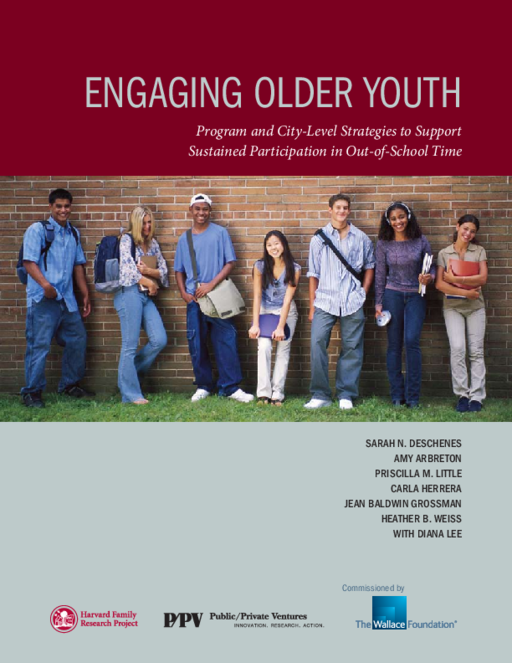Breadcrumb
- Wallace
- Reports
- Engaging Older Youth Program And...
Engaging Older Youth
Program and City-Level Strategies to Support Sustained Participation in Out-of-School Time

- Author(s)
- Sarah N. Deschenes, Amy Arbreton, Priscilla M. Little, Carla Herrera, Jean Baldwin Grossman, Heather B. Weiss, and Diana Lee
- Publisher(s)
- Harvard Family Research Project and Public/Private Ventures
Summary
How we did this
This study brought together both survey data from a large sample of out-of-school-time (OST) programs for older youth and in-depth interview data. Researchers collected and integrated qualitative and quantitative data, weaving together findings to understand program characteristics and support from city initiatives.
Participation in out-of-school-time (OST) programs by middle and high school-age young people can result in higher rates of graduation and school attendance. Yet, programs still struggle to attract and engage youth in this age group.
Five Program Characteristics
With that in mind, this study evaluated almost 200 programs in six cities that serve mostly low-income youngsters. It pinpoints five program characteristics that lead to sustained participation:
- Providing many leadership opportunities to young people. That gives youth a sense of belonging and a highly visible role—important connections they may not get elsewhere.
- Ensuring that staff members stay informed about students’ lives outside of programs. Staff members in high-retention OST programs do more than interact informally and one-on-one with youth. They also do everything from making school visits to contacting parents regularly.
- Being community-based. That’s particularly important for high school students, who might not be inclined to stay at their schools after the last bell.
- Holding regular staff meetings to discuss issues related to programs. They provide opportunities for problem solving, professional development, and staff interaction.
- Enrolling at least 100 students. That likely indicates a stronger organizational infrastructure, better resources, and stronger programs.
The study explored other effective retention and recruitment practices, including:
- Providing developmentally appropriate activities and incentives
- Using peers and staff members as recruiters
- Fostering a sense of community through connections to program staff and peers
- Matching program attributes to youth needs
- Engaging families
Addressing Different Needs
Program leaders also reported important differences in meeting the needs of middle school students vs. high school students.
For example, successful middle school programs create structures that make youth feel comfortable and safe. High school programs, on the other hand, focus on giving young people more responsibility through job-like programming, apprenticeships, and mentoring.
City Support
Cities can support these initiatives through a variety of steps. They include boosting recruitment efforts, developing tools for assessing program quality, and forming effective working relationships with school districts.
Key Takeaways
- Giving teens leadership opportunities in OST programs may contribute to retention by providing them with a sense of belonging and a highly visible role.
- Staff members in high-retention OST programs do more than interact informally and one-on-one with youth. They also do everything from making school visits to contacting parents regularly.
- Successful programs for older youth hold regular staff meetings to discuss program issues.

Once older youth have enrolled in OST programs, meaningful and sustained participation is a key factor in attaining positive outcomes.
Materials & Downloads
What We Don't Know
The study evaluated participation in a single program. But older youth are likely to take part in a variety of OST programs over the course of a year. As a result, there may be other factors that predict sustained participation more generally.

